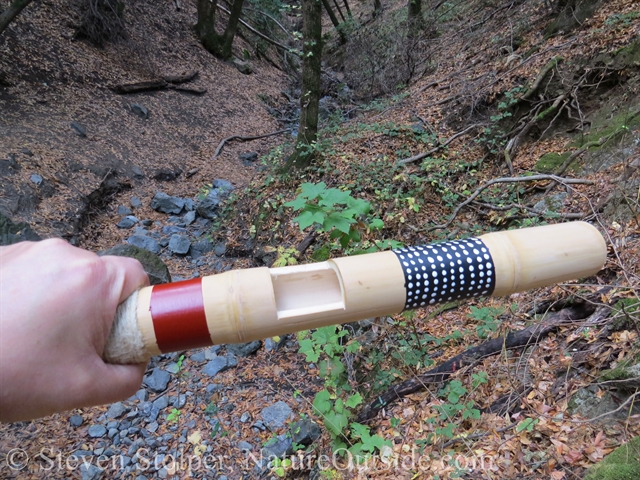
Clap! Clap! Clap!
The dancers’ bodies sway to the rhythm as an elder begins to chant.
Clap! Clap! Clap!
The dancers are all ages. Men, women, teenagers, and elders. They wear the traditional regalia of their people.
Clap! Clap! Clap!
These are the descendants of Native Californians. The first peoples of California. Who settled California more than 12,000 years ago. Who lived on the land before the Europeans came.
Ho!
The dance is over. And those of us in the crowed feel grateful to have shared this moment.
I am at an Ohlone Day, one of several such celebrations in the San Francisco Bay Area. The gathering celebrates and shares the culture, crafts, and skills of the area’s Native Peoples.
Dancing is an important part of these gatherings. And the singing reminds me of the chanting that is part of my own heritage. But a distinct feature of the Ohlone dancing is the percussion instruments they use: Clapper Sticks.
Clapper Sticks
I’ve read that ancient Californians did not use drums to accompany dances like peoples of other regions. Instead they used clapper sticks.
These unique percussion instruments make a loud clapping sound. They provide the backbeat and tempo for the dancers and singers.
Here is a picture of a clapper stick.
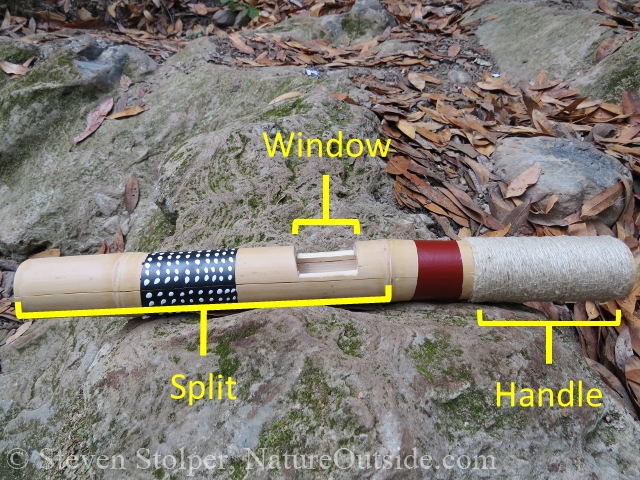
The clapper stick has three distinct parts: The handle, the window, and the split that creates an upper and lower “clapper.”
The stick is hollow. The split allows the halves to separate and clap together when struck against the open palm of a hand, or shaken vigorously. When I made my first clapper stick, I assumed that the longer the split the louder the clap. But I was mistaken. The secret is the window cut into the top half of the stick. After removing material to make the window, thin strips remain connecting the handle to the top half of the clapper. This creates a flexible hinge. By making a larger window, you increase the deflection of the upper portion and make a louder clap.
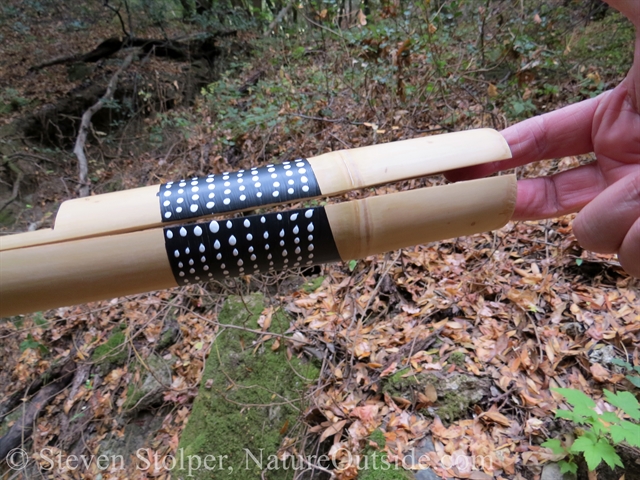
The two halves of the clapper stick separate and clap back together.
Traditional Clapper Sticks
Traditional clapper sticks are made using a branch from an Elderberry Tree (Sambucus nigra). Makers of traditional clapper sticks tell me that they use green Elderberry because it splits nicely.
When I first saw a clapper stick up close, I assumed the maker split the wood, scraped out the pithy center, and glued the two halves back together. I was wrong!
Several craftsman tell me that they first remove the bark from the branch, but leave it on the handle. Then they split the branch, but only as far as the top of the handle! They remove the pith by scraping it out using the tip of a deer antler. The tool is inserted into the split from the side.
One craftsman tells me that after he removes the pith, he props-open the halves with a shim while they dry. This allows them to dry at an angle, which makes the clapper stick louder.
Often clapper sticks are decorated by burning the wood. Most of the time this is done with wood burning tools. But I also saw a beautiful clapper stick made by holding it over a campfire to singe it. The pattern of light and dark gave it a wonderful, earthy look.
Making My Clapper Stick
I have always wanted to make my own clapper stick. But I despaired of ever having the chance. Elderberry is not available where I live. The trees are native to my area. But they disappeared when people paved-over natural habitat to make way for suburban homes, lawns, and shopping malls.
I occasionally discover an Elderberry tree on my hikes through public lands. But I will not take from them. The trees are so rare that, even if it were legal, it would be unethical because so few remain in the area.
But one day I stumbled onto an opportunity! At a local Ohlone Day celebration, I saw that a craftsman agreed to hold a clapper stick making workshop. I was so excited! I literally ran to sign up for the class. But I needn’t have worried. I was one of only two students to sign up.
Clapper Stick Class
The teacher, Isaac, is Rumsien/Ka-koon-ruk. Isaac explains that for many ceremonies he uses bamboo instead of elderberry. The material is commonly available and inexpensive. And since bamboo is already hollow, he can make many clapper sticks quickly. This is important for large dances and ceremonies.
Our class uses bamboo. And I’m a little disappointed. I won’t learn to make a traditional clapper stick. But I’m grateful for Isaac’s tutelage. He’s soft-spoken and a patient teacher. He mentions that this is the first time he’s ever taught clapper stick making to the public.
Isaac notices that I have experience carving with a knife. So he asks me never to sell any clapper sticks I make. Like many Native Americans, Isaac is sensitive to the problem of non-Indians appropriating Native American culture for profit. Historically, this has been a problem for native peoples. I willingly agree never to sell any clapper sticks I make.
Unfortunately, I never ask Isaac if I can teach others the techniques he shows me. Since I do not have his explicit permission, I do not include any of his instructions or techniques for making clapper sticks in this article. But if you search online, you can find instructional videos from Native American craftsmen who share their method for making them.
Below are some pictures of the clapper stick I made. Around the handle, I whipped jute twine. Besides giving me a better grip, it covers for a mistake I made during the class. Believing that the longer split gave a louder clap, I made the split far too long. The whipping helps to keep the split from growing and splitting the clapper stick apart.
After the class, I decorated my clapper stick using interior/exterior wood paint. I had some sample-size containers from a local big-box store. I maintained the tradition of decorating the clapper stick symmetrically. Any design on the upper half I repeated on the lower. But I chose not use Native American symbols. I am not Native American, and I do not want to miss-identify myself. Instead, I put two stripes around my clapper stick. The black stripe with the white dots represents night. The red stripe represents joy and the warmth of the campfire.
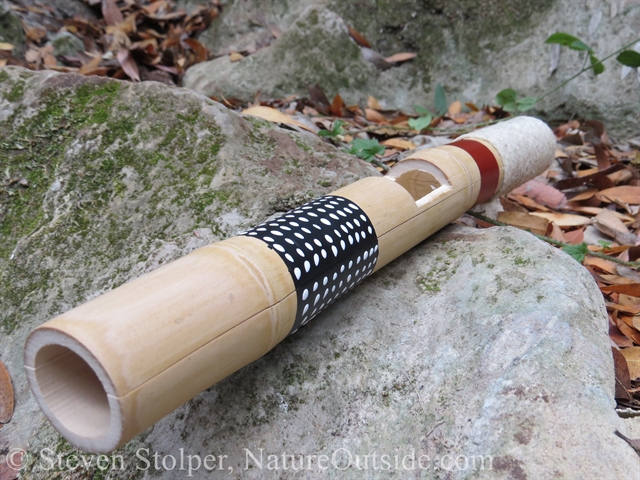
My bamboo clapper stick
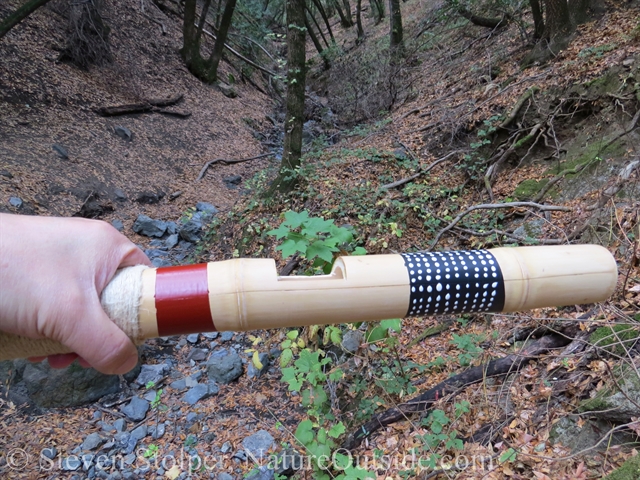
My clapper stick seen from the side. The window is cut into the upper half of the clapper.
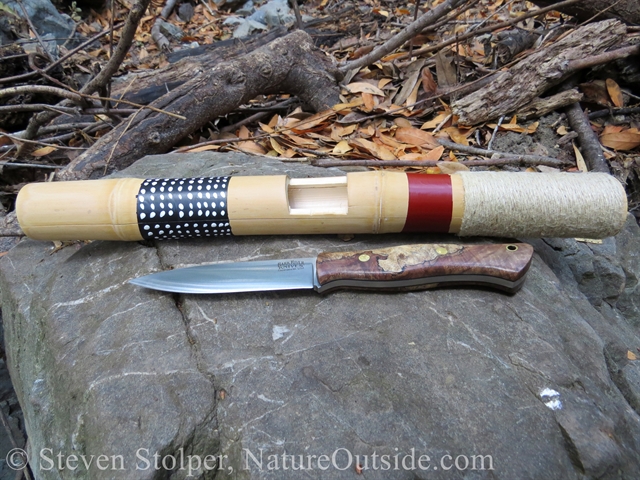
The clapper stick is roughly the length from my elbow to the tip of my fingers. The knife blade is 4.5 inches long.
Clapper Sticks in Action
Clapper sticks are played in two ways. The most common method is to hold the handle in the dominant hand, window up, and strike the bottom against the open palm of the other hand. This provides a steady rhythmic backbeat.
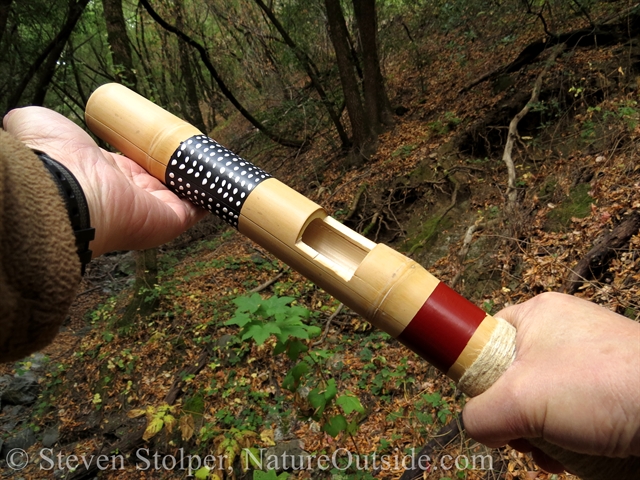
Playing my clapper stick by striking it into my open palm.
The other method is to hold the clapper stick vertically by the handle. Using the wrist, shake the clapper vigorously. This gives a staccato “16th note” feel. It has a lot of energy, but takes practice to produce a steady stream of claps.
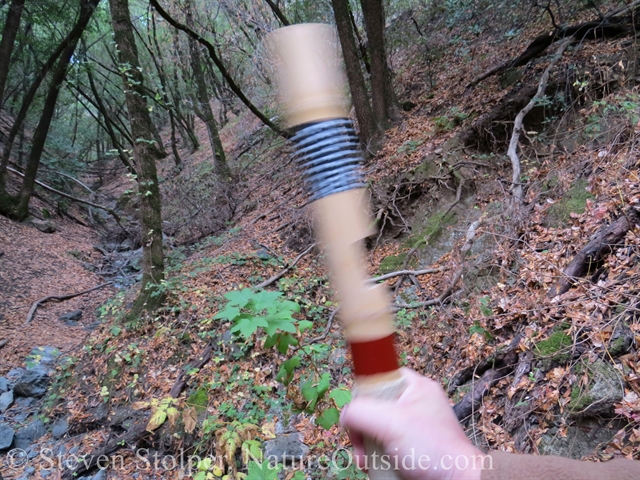
Playing my clapper stick by holding it upright and shaking it.
A curious onlooker watched me closely. I hope he enjoyed my performance. 🙂
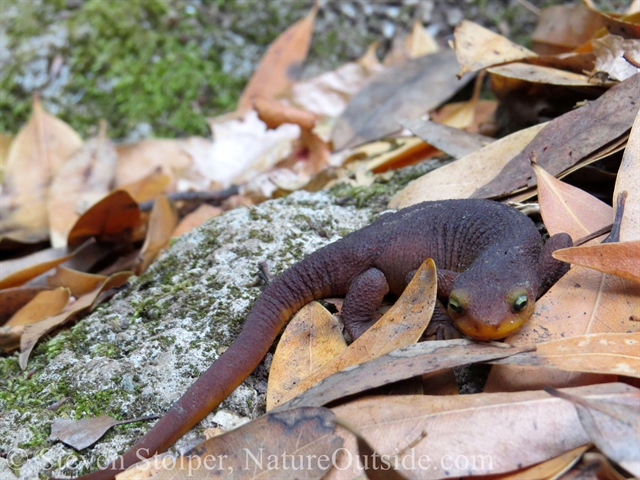
A California Newt watches me closely.
How to Use Clapper Sticks Videos
Below are several videos that show how to play clapper sticks. All the videos are filmed in California. But they are from different parts of California than where I live.
Planting Song
A traditional Acjachemen Planting Song using elderberry clapper sticks, sung by members of Tushmalum Heleckum, the Hummingbird Singers, from the San Juan Capistrano area.
California Native Song
Traditional Southern California tribal song by traditionalist Jacque Nunez of Journeys To The Past. Filmed at the Heritage Park Native Village in Santa Fe Springs, California.
Further Reading
The links below are affiliate links.
Survival Skills of Native California, Paul D. Campbell
The Ohlone Way: Indian Life in the San Francisco-Monterey Bay Area, Malcolm Margolin
Tending the Wild: Native American Knowledge and the Management of California’s Natural Resources, M. Kat Anderson
The Ohlone Past and Present: Native Americans of the San Francisco Bay Region, Lowell John Bean (Editor)
Related Articles on NatureOutside
The Tuibun of Coyote Hills (Part 2)
For fun facts and useful tips, join the free Bushcraft Newsletter.



Great offering. It reminded of a rhythm instrument that hula dancers often use called the puili. Rhythm is ever present. Cheers, Hal
Thanks for your comment Hal. I had never heard of puili before and looked them up. They look fascinating.
Absolutely beautiful songs. Love everything about the information you share. Thank you x x x x
You’re welcome, Janette. I’m glad you enjoyed the article.
Why not use an elderberry?
Sunny, this is a great question! Elderberry is the material traditionally used by the Ohlone Peoples to fashion Clapper Sticks. But there has been so much habitat destruction in my area that Elderberry is not plentiful and often grows only in areas protected as plant and wildlife refuges. So using bamboo is an inexpensive way to make Clapper Sticks without harvesting a limited resource.